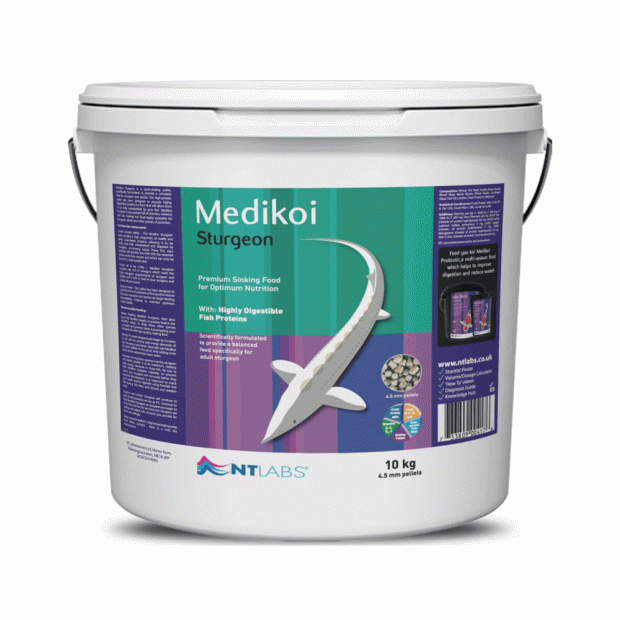- Grows to a max size of ~180cm
- Active, bottom-feeding pond fish
- Only suitable for big ponds with a large surface area
Overview
Everything you need to know about Diamond Back Sterlet, at a glance:
- Common Names: Diamond Back, Starry Sturgeon
- Scientific Name: Acipenser stellatus
- Max Size: ~180cm when kept in pond, grow larger in wild
- Temperature Range: 10-18°C
- pH Range: 6.5-8.0
- Compatibility: Only suitable for large ponds, but can live alongside other pond fish like Koi
- Area Of Origin: Eurasia
- Suitable Foods: Specialist sinking pellets
- Special Requirements: Need to be kept in large and deep ponds with lots of aeration, also limit amount of submerged plants to prevent Sterlet from getting entangled
What is a Diamond Back Sterlet?
A Diamond Back Sterlet, also known as a Starry Sturgeon, is a large, bottom-dwelling fish that’s popular amongst experienced pond keepers. They’re just one of 28 species that make up the family Acipenseridae (Sturgeon).
Unlike other types of Sterlet, Diamond Back Sterlets can grow quite large, reaching lengths of ~180cm. They’re similar in size to Siberian Sturgeons and come from similar areas around Russia and Eurasia. They also inhabit fast-moving, well-oxygenated rivers and streams.
This particular species is characterised by a series of scutes that run in lateral lines down their backs. They also have very long noses, longer even than Common Sterlets which are well known for their elongated rostrums. Like other Sterlets and Sturgeons, Diamond Backs are counter shaded and typically have dark-coloured backs and pale-coloured bellies.
How do I care for a Diamond Back Sterlet?
A Diamond Back Sterlet requires a lot of specialist care, making it an unsuitable choice for a first-time pond keeper. They need lots of space, both in terms of depth and surface area. To keep just one individual, you’ll need a pond that’s at least 1.2m deep and can hold 5,000+ litres of water, though bigger is always better.
In order to simulate a Diamond Back Sterlet’s natural environment, you’ll also need to provide them with a lot of additional oxygen. The best way to do this is with a water feature, like a pond fountain or a waterfall, and a powerful air pump that can run a series of large air stones. This will increase the rate of oxygen exchange in your pond, keeping your Diamond Back Sterlet healthy and happy.
Another thing to consider when keeping Diamond Back Sterlet is the base of your pond. These are bottom-feeding fish that sift through loose substrate in search of food, so they prefer a largely flat-bottomed pond without too many sloping areas. You should also keep submergent plants to a minimum, as Diamond Back Sterlet are clumsy swimmers that can get easily caught up in them. Some types of free-floating algae, like blanket weed, are particularly dangerous for Diamond Back Sterlet.
As scaleless fish, Diamond Back Sterlet are particularly sensitive to chemicals. This means that a large number of pond treatments are unsuitable for use in ponds housing Diamond Back Sterlet. If you keep Diamond Back Sterlet and you’re having problems with algae, particularly blanket weed, then it's a good idea to install a UV clarifier or a pond filter with a UV unit built into it. They’re also not fond of lots of light, so be sure to offer them lots of shady places to hide.
Like other species of Sturgeon, Diamond Back Sterlet are carnivores that need to be fed a diet of specialist sinking pellets high in protein. If you keep other fish in your pond, then it’s recommended that you feed them first to keep them occupied, and then toss some sinking pellets into a different part of your pond for your Diamond Back Sterlet. A number of small feeds every day is better for Diamond Back Sterlet than one large feed, though be careful not to overfeed.
Unlike most other types of pond fish, Diamond Back Sterlet should continue to eat high-protein foods throughout winter. They’ll also continue feeding right down to 4°C, so make sure that you regularly offer them food to avoid problems related to malnourishment. That said, do promptly remove any uneaten food to avoid polluting your water.
How is this Diamond Back Sterlet delivered?
All of our aquatic animals are dispatched from our livestock distributor and delivered directly to your doorstep. Our distributor dispatches and delivers livestock packages Tuesday through Friday to avoid animals being in transit over the weekend. To further minimise time spent travelling, all livestock deliveries are made before 1pm on the day of delivery.
After placing your livestock order, you’ll receive all the information needed to track your livestock order via email. If you have any problems regarding delivery, or concerns about the health/wellbeing of your animal(s) upon arrival, please contact us, Swell UK Ltd, immediately, or at least within 48 hours of receiving your livestock order.
Any other, non-livestock items that you purchase alongside livestock will be sent via standard or express delivery and arrive at your delivery address in a different package. This means that, depending on when you place your order, you may receive your non-livestock items before or after your livestock package.
For a detailed breakdown of when you can expect to receive your livestock package depending on the day you placed your order, be sure to check the delivery details in the specifications below.
How do you acclimate a Diamond Back Sterlet to a pond?
It’s very important that you acclimatise new fish to your pond. This is the process of gradually adjusting an animal to its new environment and it’s especially important in an aquatic setting where sudden changes in water temperature, pH, and nitrates can cause stress, illness and, in some cases, even death.
To acclimatise your Diamond Back Sterlet, add it to a large, dimly lit container and add a small amount of pond water every few minutes. Do this until water temperatures in this container match water temperatures in your pond. If you don’t have a large container to hand, you can float the bag containing your fish in your pond instead.
You should always set up your pond and make sure it’s ready for fish prior to purchasing any. It’s also a good idea to let your pond filter mature for a few months before adding a Diamond Back Sterlet. A single Diamond Back Sterlet can produce a lot of mess; your pond filter needs to be able to handle this if it’s to maintain a healthy environment. For more information about keeping Sterlet and Sturgeon, check out our help guide here.
Above photos are for illustration purposes only; livestock received may not exactly match those photographed.
Livestock Delivery Timetable
| Order On | Receive On |
| Monday | Wednesday |
| Tuesday | Thursday |
| Wednesday | Friday |
| Thursday | Tuesday |
| Friday | Tuesday |
| Saturday | Tuesday |
| Sunday | Tuesday |
-
 Albino Golden SterletFrom £150.00In stock
Albino Golden SterletFrom £150.00In stock -
 SterletFrom £60.00In stock
SterletFrom £60.00In stock -
 Siberian SturgeonFrom £60.00In stock
Siberian SturgeonFrom £60.00In stock












